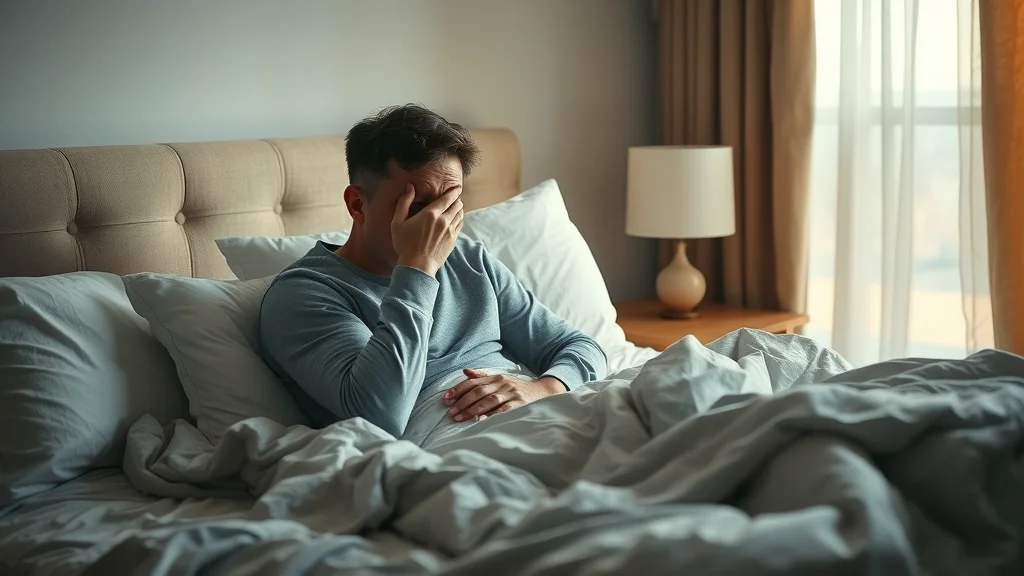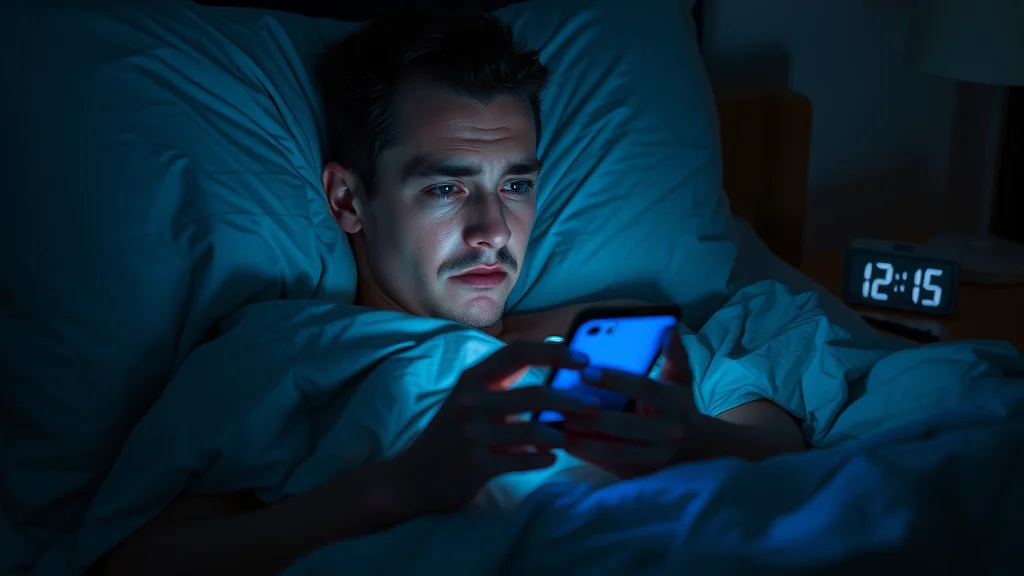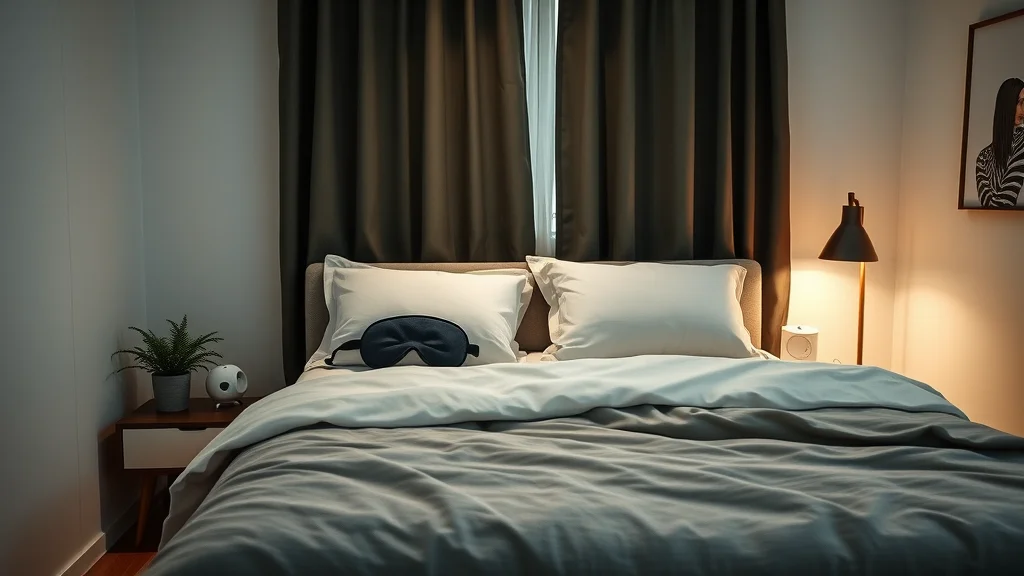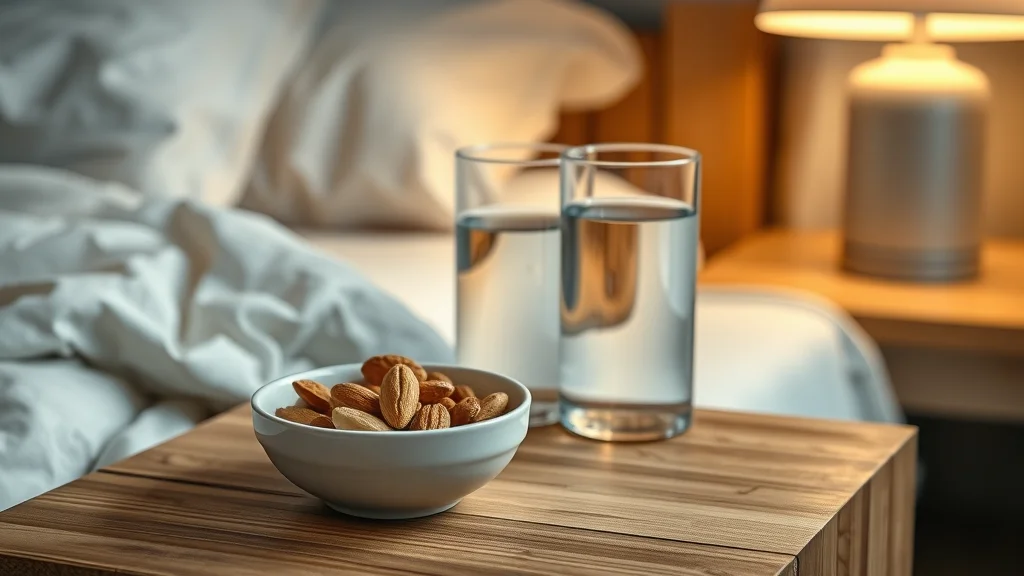Ever asked yourself, “Why do I feel groggy after a full 8 hours of sleep?” You’re not alone—millions wake up tired despite sleeping what’s classically considered ‘enough.’ What if the magic number isn’t the whole answer?

Are You Sleeping 8 Hours But Still Tired? The Overlooked Problem
"Even if you think you've had a full night, the real measure is how rested you feel—hours of sleep aren't always the answer."
Waking up groggy or with brain fog even after eight hours in bed
Needing multiple alarms to get out of bed
Yawning or craving naps throughout the day
Feeling tired, slow, or unmotivated despite a regular sleep schedule
Complaining “I slept a full night but I’m still exhausted”
Millions report waking up tired and low on energy after ample hours of sleep.
The disconnect between hours of sleep and feeling rested highlights that sleeping 8 hours but still tired is a widespread issue linked to poor sleep quality and irregular sleep schedules.
With life’s demands and digital distractions, poor sleep and fatigue are increasing across all ages and lifestyles.

How Much Sleep Do You Really Need? The Truth About Hours of Sleep
If you’re waking up tired after a full night, it’s natural to wonder: do you really need exactly eight hours of sleep? Conventional wisdom says yes, but sleep science emphasizes that the ideal hours of sleep vary for everyone, influenced by age, biology, lifestyle, and genetics. While hours of sleep can be a useful guideline, what matters more is how well you sleep and whether your “full night” leaves you restored.
Table: Recommended Hours of Sleep by Age Group
Age Group |
Recommended Hours of Sleep |
|---|---|
Teenagers (14-17 years) |
8-10 hours |
Adults (18-64 years) |
7-9 hours |
Older Adults (65+ years) |
7-8 hours |
Eight hours is a guideline, not a guarantee—you might need more or less based on your health and habits.
Personal factors like stress, genetics, and daily routines can influence your unique need for deep sleep.
Some people feel energetic after just six hours, while others need over nine for optimal focus and moods.
Tracking your energy levels and alertness is a better indicator than counting hours of sleep alone.
Why Do Some People Wake Up Tired Despite a Full Night?
There’s a growing recognition that the amount of sleep isn’t the full story: sleep quality and deep sleep during each cycle matter as much, if not more, than the total hours of sleep. You can be following a consistent sleep schedule and still wake up tired if your body isn’t completing enough deep sleep or restorative sleep stages. Factors such as stress, sleep disorders, or frequent interruptions can keep you in light sleep, resulting in poor sleep quality.
Additionally, individual sleep needs vary significantly. Some people physically require more deep sleep to wake up feeling rested, while others experience normal energy levels with fewer hours. This is why you may consistently sleep a full night but still feel tired day after day, especially during periods of physical or mental health challenges.
Quality rest—achieved by aligning your regular sleep with your natural circadian rhythm and minimizing disruptions—matters more than checking the “eight hour” box. Understanding what interrupts your sleep or prevents you from progressing through healthy sleep cycles can be key.

Sleep Quality vs. Quantity: Why You May Still Feel Tired
Getting eight hours in bed isn’t the same as getting eight hours of restorative sleep with high sleep quality and sufficient deep sleep. Sleep quality is determined by how well you progress through all sleep stages, including deep sleep and REM sleep. If you’re frequently waking up during the night, or your deep sleep is disrupted, you’ll likely wake up feeling tired even if you spent long hours asleep. Regular sleep is only beneficial if it’s undisturbed and matches your body’s needs.
Many factors, such as environment, diet, and stress, influence whether your sleep is fragmented or solid. Poor sleep habits, such as inconsistent bedtimes or using electronics close to bed, often reduce the time your brain spends in the most restorative stages. For some, even mild sleep disorders go undetected, stealing away vital deep sleep. The key takeaway: focus on sleep quality as much as you focus on the sheer amount of sleep.
While improving your sleep quality is essential, it's also important to address the underlying stress that can sabotage your rest. Simple techniques, such as targeted relaxation exercises, can make a noticeable difference—explore how a quick method like tapping your lip for instant calm may help reduce nighttime anxiety and support deeper, more restorative sleep.
What is Poor Sleep Quality and How Does It Impact Feeling Tired?
Poor sleep quality means you’re not progressing efficiently through all essential sleep cycles—light, deep sleep, and REM—leading to waking up tired despite a full night. Insufficient deep sleep, in particular, limits your body’s ability to repair, consolidate memories, and refresh hormonal balances. Often, poor sleep can result from frequent awakenings, not being able to fall asleep quickly, or spending time awake in bed. These interruptions may go unnoticed, but they add up to waking up tired—even if you don’t realize you had restless sleep.
Late-night screen use, caffeine consumption close to bed, noisy or uncomfortable environments
Unmanaged stress and anxiety, which prevent you from reaching restorative deep sleep
Medical sleep disorders (like sleep apnea or restless legs syndrome) that fragment sleep stages
"Quality matters more than quantity when it comes to waking up feeling refreshed."
Deep Sleep and Its Role in Feeling Rested
Deep sleep (also known as slow-wave sleep) is when your body truly restores itself—unlike light sleep, which is easier to wake from.
Not getting enough deep sleep, even with a full night’s hours, leaves you groggy with poor memory and low energy during the day.
Key signs of insufficient deep sleep include waking up tired, lack of focus, muscle aches, and a weakened immune system.
Fitness trackers and sleep monitors can help reveal a deficit in this crucial sleep stage.

Regular Sleep Schedule and Its Effects on Sleep Quality
Maintaining a regular sleep schedule strengthens your body’s circadian rhythm—the internal clock that regulates sleep quality and wake cycles—helping you avoid waking up tired. Going to bed and waking up at consistent times helps your brain recognize when it’s time for deep, restorative sleep. Irregular sleep schedules, such as sleeping in on weekends or staying up late, disrupt this clock, making it harder to achieve high-quality sleep and leaving you feeling tired during the day.
Stability is crucial. People who maintain a steady bedtime and wake time are more likely to move smoothly through all sleep stages and wake up refreshed. Even if you get eight hours of sleep, inconsistent bedtimes can disrupt your sleep quality and cause you to wake up tired, regardless of the total hours of sleep.
Common Causes of Waking Up Tired After Sleeping 8 Hours
Hidden Sleep Disorders That Can Disrupt a Full Night
Sleep apnea: Repeated pauses in breathing lead to frequent awakenings and prevent deep rest
Insomnia: Trouble falling asleep or staying asleep, despite adequate time in bed
Restless legs syndrome: Urge to move legs, disturbing the sleep cycle
Circadian rhythm disorders: Misalignment between natural sleep cycles and social schedules
Even mild sleep disorders can cause poor sleep and chronic tiredness, with sufferers sometimes unaware they’re waking repeatedly throughout the night.
Medical sleep disorders should always be evaluated by a healthcare provider or sleep specialist if you routinely wake up tired, as these conditions can pose major health risks.
Poor Sleep Hygiene and Daily Habits That Sabotage Your Rest

Late-night phone use or watching TV before sleep delays deep sleep onset
Eating heavy meals, drinking caffeine or alcohol close to bed
Having an irregular sleep routine, inconsistent bedtimes/wake times
Neglecting a comfortable, dark, quiet sleep environment
Poor stress management or lack of wind-down activities before bed
Stress and Anxiety: Their Impact on Hours of Sleep and Feeling Tired
Unchecked stress and anxiety reduce your ability to fall asleep, trigger night awakenings, and lower deep sleep quality
Persistent worries or racing thoughts at night make it harder to wake up feeling refreshed, regardless of hours of sleep
Addressing mental health is as vital as managing physical sleep hygiene
Physical Health and Underlying Medical Conditions
Thyroid disorders, anemia, diabetes, and chronic pain conditions can cause persistent fatigue even after a regular sleep schedule
Disease-related sleep issues often require a comprehensive medical assessment
If lifestyle changes don’t help, consult your healthcare provider to rule out underlying conditions affecting your energy levels

Signs Your Full Night of Sleep Isn’t as Restful as You Think
Regularly waking up tired, foggy, or irritable despite sleeping 7–9 hours
Difficulty concentrating, frequent headaches, or feeling tired even after naps
Partner notices snoring, gasping, or restlessness in your sleep routine
Daytime fatigue that impedes work, school, or physical activity
Falling asleep quickly anytime you sit or lie down during the day
Cravings for caffeine or sugar just to get through ordinary tasks
"If you're sleeping 8 hours but still tired, your body could be sending you vital signals that something's wrong."
How Sleep Cycles Affect Waking Up Tired – Watch this short animated explainer to understand how your body cycles through different sleep stages each night.
Improving Sleep Quality: Practical Steps If You're Sleeping 8 Hours But Still Tired
Optimize Your Sleep Environment for a Full Night
Your sleep environment can make or break your chances for deep, restorative sleep. Cool, dark, quiet bedrooms increase deep sleep and help you wake feeling refreshed. Invest in comfortable bedding, blackout curtains, and consider white noise if you’re sensitive to sound. Remove screens and digital distractions at least an hour before bed to enhance quality sleep and avoid waking up tired. Maintaining healthy sleep hygiene is a simple yet powerful strategy.
Keep your room cool, dark, and quiet
Limit noise by using earplugs or white noise machines
Use blackout curtains to reduce light pollution
Ensure your mattress and pillows are supportive and comfortable
Keep screens (phones, tablets, TVs) out of the bedroom

Establishing a Regular Sleep Schedule for Better Sleep Quality
Consistency in your sleep-wake cycle is the cornerstone of better sleep quality. Going to bed and waking at the same time every day helps your body fall asleep faster and increases the hours of deep sleep. Creating bedtime routines that signal your brain it’s time for rest—like reading a book or gentle stretches—further supports your sleep schedule.
Go to bed and wake up at the same time—even on weekends
Establish relaxing bedtime rituals (journal, reading, warm bath)
Limit large meals and caffeine hours before bed
Set an alarm for winding down, not just waking up
Track and adjust your regular sleep schedule for patterns in your sleep quality

Prioritizing Mental Health to Prevent Waking Up Tired
Practice mindfulness, meditation, or gratitude journaling before bed
Use stress reduction activities like gentle yoga, listening to calm music, or aromatherapy
Seek therapy or counseling if stress and anxiety are chronic
Limit exposure to negative news or heated discussions close to bed
When to Seek Professional Help for Feeling Tired Despite Sleeping 8 Hours
If you snore loudly, gasp for air, or your partner notices stops in breathing
Daytime fatigue disrupts your ability to function or stay awake
Symptoms persist for weeks despite improving sleep hygiene and routines
Medical or mental health concerns are suspected
Lifestyle Factors and Diet: Their Role in Sleeping 8 Hours But Still Tired
How Nutrition Impacts Sleep Quality and Waking Up Tired
Magnesium-rich foods (almonds, bananas) and foods high in tryptophan (turkey, oats) encourage deep sleep
Heavy, spicy, or sugary foods can disrupt sleep quality and contribute to waking up tired
Caffeine or alcohol in the evening can interfere with your sleep cycle more than you’d expect—swapping for water or herbal tea helps sustain quality sleep
Staying hydrated supports proper sleep stages and stronger energy levels in the morning

Physical Activity: Its Effects on Hours of Sleep and Feeling Rested
Moderate exercise (walking, yoga, swimming) during the day improves both amount of sleep and quality sleep at night
Exercising too close to bedtime may make it harder to fall asleep—ideally, finish workouts at least 3 hours before bed

Myth-Busting: Debunking Common Misconceptions About Hours of Sleep
Not everyone needs exactly 8 hours to avoid feeling tired—your needs are personal and can shift with age, activity, and health
A full night of uninterrupted, deep sleep matters more than just hitting a magic number
Focus on sleep quality and regular schedules rather than sleeping extra hours on weekends to “catch up”
Even napping can disrupt your sleep cycle if taken too late in the day or if it affects your ability to maintain a regular sleep schedule
"A regular sleep schedule and understanding your body's needs matter more than the magic number 8."
Interview with a sleep psychologist busting the “full night” sleep myth and helping you understand optimal sleep quality.
People Also Ask: Why am I still exhausted after 8 hours of sleep?
Answer: Possible Reasons for Waking Up Tired After a Full Night
Your sleep quality may be poor due to stress, environmental distractions, medical issues, or irregular sleep schedule
You’re not getting enough deep sleep—too much time in light sleep or frequently waking can leave you tired
Possible undiagnosed sleep disorders (like sleep apnea or restless legs syndrome) are disrupting your full night’s rest
Diet, exercise, mental health issues, and even certain medications can impact your sleep cycle
Real Stories: Individuals Overcoming Feeling Tired After Sleeping 8 Hours
“I discovered my ‘full night’ of sleep wasn’t deep enough after a home sleep study, so I started using a white noise machine and blackout curtains—now I wake up feeling rested.”
“Diagnosing sleep apnea changed my life. Treatment with a CPAP helped me finally stop waking up tired after years of exhaustion.”
Most successful strategies involved addressing sleep hygiene, tracking sleep cycles, consistent schedules, and getting help for underlying sleep disorders when necessary
Adopting stress rituals and making time for mental health boosted both sleep outcomes and daytime energy levels

Frequently Asked Questions About Sleeping 8 Hours But Still Tired
What defines poor sleep quality? Poor sleep quality means frequent awakenings, trouble falling asleep, shallow sleep, or spending limited time in deep and REM sleep phases—often resulting in waking up tired.
How do I track my sleep cycles for better insights? Sleep trackers, apps, or home sleep studies monitor your sleep stages; recognizing patterns can help you improve regular sleep and wake up feeling more energized.
When should I suspect a sleep disorder? If you regularly wake up tired, suffer unexplained fatigue, or snore/gasp during sleep, talk to a healthcare provider about a potential sleep disorder.
Can stress and anxiety make me feel tired despite regular sleep? Absolutely; mental health factors greatly reduce sleep quality and keep your brain too alert for restorative sleep.
What’s the role of diet and exercise in avoiding waking up tired? Balanced nutrition and regular physical activity both enhance sleep quality; avoid caffeine, alcohol, and heavy meals close to bed for more restorative rest.

Key Takeaways: Overcoming Waking Up Tired After Sleeping 8 Hours
Focus on improving sleep quality and deep sleep, not just the number of hours of sleep, to avoid feeling tired after a full night
Establish a regular sleep schedule and strong sleep hygiene
Manage stress and prioritize both mental and physical health
Evaluate nutrition, hydration, and physical activity routines
Don’t hesitate to consult a sleep specialist for persisting symptoms
Ready to Finally Wake Up Refreshed? Assess Your Sleep Habits, Take Action, and Discover Personalized Solutions Today.
Start optimizing your sleep tonight—adjust your environment, stick to a routine, address health factors, and don’t ignore persistent sleep issues. A refreshed morning is closer than you think!
If you’re committed to improving your sleep and overall well-being, consider how your daily health choices play a role in your energy and resilience. For a broader perspective on maintaining vitality as you age, explore the latest insights from high-profile health assessments—such as what annual physical exams reveal about adult health.
You’ll discover actionable strategies that go beyond sleep, empowering you to take charge of your health journey and wake up ready for whatever the day brings.
Sources
NIH – National Institute of Neurological Disorders and Stroke – https://www.ninds.nih.gov
American Sleep Association – https://www.sleepassociation.org
If you’re consistently sleeping eight hours but still waking up tired, it’s essential to evaluate both the hours of sleep and the sleep quality, including factors like sleep disorders and mental health. Factors such as sleep disorders, lifestyle habits, and environmental conditions can significantly impact how rested you feel upon waking.
For a comprehensive understanding of why you might be experiencing fatigue despite adequate sleep, consider reading “Why You’re Tired After 8 Hours of Sleep” by the Cleveland Clinic. This resource delves into potential causes like sleep disorders, thyroid issues, and environmental factors that could be affecting your sleep quality.
Additionally, “Why you’re still tired after eight hours of sleep” by nib offers practical tips to enhance your sleep hygiene, such as maintaining a consistent sleep schedule, reducing screen time before bed, and optimizing your sleep environment.
We hope you found this content helpful. By exploring these resources, you can gain valuable insights into the underlying reasons for your persistent fatigue and discover actionable strategies to improve your sleep quality and overall well-being. NCWellnessHub.com
 Add Row
Add Row  Add
Add 




Write A Comment